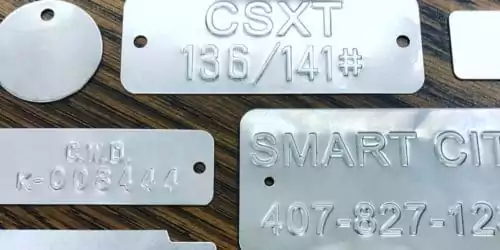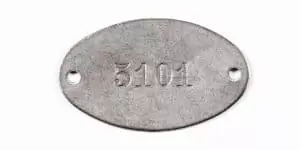Embossing
An embossed tag features characters that are raised up from the surface of the metal. They are produced using a specialized embossing machine or using a male and female die set.
Durability
Embossed tags are extremely durable. They are one of the strongest metal tag solutions on the market. The nameplates are rated to withstand 40+ years of use. That includes holding up to some of the harshest work conditions.
In addition, they survive through extreme weather conditions. Wind, rain, or snow; your embossed nameplates will stay strong.
Stays Legible
One major benefit to embossing is there is no ink to rub off or wear away. The raised characters allow for the message or design to stay legible even in challenging circumstances.
For example, your new employee accidentally covers your nameplate with paint. If it is a stamped tag, you must wash the paint off or the information will be illegible.
This also applies to gritty, grimy work conditions. If your tags get covered in dirt or oil they aren’t so easy to read. This is where embossed tags really shine. The raised area means your message can still show through.
In comparison, no other metal tag processes offer this benefit. While processes such as engraving and stamping are very durable, if they get covered in paint or another substance the message will be obstructed. They then need to be cleaned, which takes time and is one additional task you wouldn’t have to complete if using embossing.
Material
Aluminum
One of the most popular choices for embossed material is aluminum. It has some advantages over comparable metals. The anodization process creates not only higher durability and resistance, but also the option for colorization. Unlike some other material options, aluminum is very lightweight. However, it doesn’t sacrifice durability.
The anodization process allows for the material to be embedded with a single color. For example, a purple anodized placard will feature the same hue for the characters as well as the background.
Color added to anodized nameplates is used for a wide range of purposes. Some organizations use them for color coordination. For example, keeping warning signs a particular shade. Plus, they are perfect for quick and seamless asset identification and tracking.
Stainless Steel
Stainless steel is another popular choice for embossed tags. This material offers the highest level of durability. It is able to hold up to heavy wear and tear from the toughest work environments. It will take more than a few bumps and scrapes to damage a stainless nameplate.
Uses
-
Valve Tags
-
Asset Tracking Nameplates
-
Telephone Pole Tags
-
Product ID Tags
-
Crematory Tags
-
Tree Tags
-
Super Elevation Nameplates
-
And Many More!
Customization
Embossed nameplates feature some customizable elements. For example, a custom logo can be added to an embossed image design for an original look. There is also the ability to colorize the tags through anodized aluminum, or painted steel. This will add a singular color for the background and embossed characters.
Your type of information on the tag will be a big factor in the buying process.
An embossing die set is created for static data (same info on each tag). This allows for large scale production runs to be more economical.
For different information on each placard (variable data) it is significantly more cost effective to use embossed over stamped. With a variable data embossing machine, the setup process is all but nonexistent. There is no stamp to create either.
Stamping
The stamping process uses a manufacturing press to indent information into the metal material. The recessed characters are very durable, and are easy to read.
Durability
Similar to embossing, stamping has a very high level of durability. They are also rated for 40+ years outdoors. They are able to withstand all weather and tough working environments. There is no ink to wear off or design to fade.
One potential negative is due to the indented characters, dirt/grime/oil can cover the design, making it hard to read. Constant cleaning is more of hassle than a help.
Material
-
Aluminum
-
Stainless Steel
-
Cold Rolled Steel
-
Brass
Stamps
With some processes such as MetalPhoto, it doesn’t matter what your design is. You can have a million different tags with a million different barcodes, logos, words, etc.
Stamping doesn’t work that way. There are also some limitations to customization. Of course there are standard choices like material, shape, size. Anything beyond basic numbers requires a custom stamp to be made.
For each new design, a new stamp has to be made. In addition to creating the stamp, a press or machine must be setup for production. Both of these steps take time and money.
This makes variable data time consuming and costly for stamped tags.
However, serialized data can be a better fit. Very large quantity orders can be cranked out with serialized numbers; no big setup for each tag. This is fine for large scale production runs of one design.
Typically, the larger the order volume – the cheaper price per tag.
Wrap-Up
In short, embossing creates raised characters in the metal material, while stamping indents them.
Raised characters add the benefit of legibility even when covered in dirt or paint. Indented characters are harder to read in some situations.
Consequently, embossed tags are much more cost effective for orders which require variable data or smaller production runs. Stamped tags are more cost effective for large production runs of static (consistent) information. It just comes down to the size and specs of your order.
Both solutions are very durable, and work in a wide range of use of environments and situations. They are rated for 40+ years outdoors.
Not every tag is right for every industry. Not every nameplate is great for every environment.
At the end of the day, the best identification solution is the one that fits your application.
Call 1-800-428-0095 for your free quote of high-quality custom embossed or stamped tags.
Metal Marker provides easy ordering, and fast delivery.

